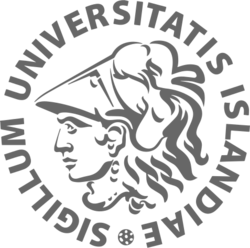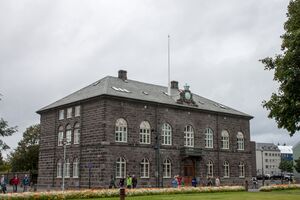Difference between revisions of "University of Iceland"
(Created page with "{{group |wikipedia=https://en.wikipedia.org/wiki/University_of_Iceland |constitutes=university |leaders= |logo= |twitter= |start=1911 |headquarters=Reykjavík, Iceland }} {{SM...") |
(unstub) |
||
| Line 3: | Line 3: | ||
|constitutes=university | |constitutes=university | ||
|leaders= | |leaders= | ||
| − | |logo= | + | |logo=University of Iceland logo.png |
|twitter= | |twitter= | ||
|start=1911 | |start=1911 | ||
|headquarters=Reykjavík, Iceland | |headquarters=Reykjavík, Iceland | ||
| + | |description=The national Icelandic university. | ||
}} | }} | ||
| + | The '''University of Iceland''' (''Háskóli Íslands'') is a [[public university|public]] [[research university]] in [[Reykjavík]], [[Iceland]] and the country's oldest and largest [[institution of higher education]]. Founded in 1911, it has grown steadily from a small civil servants' school to a modern [[comprehensive university]], providing instruction for about 14,000 students in twenty-five faculties. Teaching and research is conducted in [[social sciences]], [[humanities]], [[law]], [[medicine]], [[natural sciences]], [[engineering]] and [[teacher education]]. It has a campus concentrated around ''Suðurgata'' street in central Reykjavík, with additional facilities located in nearby areas as well as in the countryside. | ||
| + | |||
| + | ==History== | ||
| + | |||
| + | The University of Iceland was founded by the [[Alþingi]] on June 17, 1911, uniting three former post-secondary institutions: ''Prestaskólinn'', ''Læknaskólinn'' and ''Lagaskólinn'', which taught theology, medicine and law, respectively. The university originally had only faculties for these three fields, in addition to a faculty of [[humanities]]. During its first year of operation 45 students were enrolled. The first [[Rector (academia)|rector]] of the university was [[Björn M. Ólsen]], a professor in the faculty of humanities.<ref>https://www.academia.edu/32556914/University_of_Iceland_A_Citizen_of_the_Respublica_Scientiarum</ref> | ||
| + | [[Image:Parliament building, Reykjavík 2014-07-28.jpg|thumb|[[Alþingishúsið]] in Reykjavík]] | ||
| + | The university played an important role in the construction of the Icelandic nation-state and was perceived by Icelanders as an important stepping stone towards full independence. Demands for a national Icelandic university stretch as far back as to the first session of the elected assembly of Althingi in 1845. Icelandic nationalist leaders petitioned Denmark at the time to create a "national school" to achieve cultural and material progress, but also to make sure that the education that Icelanders obtained was sufficiently national in character. | ||
| + | |||
| + | For its first 29 years the university was housed in the Icelandic Parliament building, [[Alþingishúsið]], in central [[Reykjavík]]. In 1933, the university received a special licence from Alþingi to operate a cash-prize lottery called ''Happdrætti Háskólans''. The university lottery, which started in 1934, remains a major source of funding for the construction of new university buildings. In 1940, the university moved into the [[University of Iceland Aðalbygging|main building]], designed by Icelandic state architect [[Guðjón Samúelsson]]. The main building forms the core of the university campus on ''Suðurgata'', where most of the principal buildings of the university are located today. | ||
| + | |||
| + | In recent years there has been some major restructuring. In 2008 the university was divided into five different schools. Simultaneously, the [[Iceland University of Education]] was merged with the University of Iceland to become its School of Education. Increased competition from local colleges has encouraged the university to greatly improve its marketing strategies, which had previously been deemed unnecessary. | ||
| + | |||
| + | On 21 January 2021, a broken main water pipe serving the [[Vesturbær]] neighbourhood of Reykjavík flooded the campus with over 2,000 tonnes of water, causing damage to buildings Háskólatorg and Gimli. <ref>https://www.ruv.is/frett/2021/01/21/university-campus-flooded-as-water-main-bursts</ref> | ||
{{SMWDocs}} | {{SMWDocs}} | ||
==References== | ==References== | ||
{{reflist}} | {{reflist}} | ||
| − | |||
Latest revision as of 00:47, 6 February 2021
(University) | |
|---|---|
 | |
| Formation | 1911 |
| Headquarters | Reykjavík, Iceland |
| The national Icelandic university. | |
The University of Iceland (Háskóli Íslands) is a public research university in Reykjavík, Iceland and the country's oldest and largest institution of higher education. Founded in 1911, it has grown steadily from a small civil servants' school to a modern comprehensive university, providing instruction for about 14,000 students in twenty-five faculties. Teaching and research is conducted in social sciences, humanities, law, medicine, natural sciences, engineering and teacher education. It has a campus concentrated around Suðurgata street in central Reykjavík, with additional facilities located in nearby areas as well as in the countryside.
History
The University of Iceland was founded by the Alþingi on June 17, 1911, uniting three former post-secondary institutions: Prestaskólinn, Læknaskólinn and Lagaskólinn, which taught theology, medicine and law, respectively. The university originally had only faculties for these three fields, in addition to a faculty of humanities. During its first year of operation 45 students were enrolled. The first rector of the university was Björn M. Ólsen, a professor in the faculty of humanities.[1]

The university played an important role in the construction of the Icelandic nation-state and was perceived by Icelanders as an important stepping stone towards full independence. Demands for a national Icelandic university stretch as far back as to the first session of the elected assembly of Althingi in 1845. Icelandic nationalist leaders petitioned Denmark at the time to create a "national school" to achieve cultural and material progress, but also to make sure that the education that Icelanders obtained was sufficiently national in character.
For its first 29 years the university was housed in the Icelandic Parliament building, Alþingishúsið, in central Reykjavík. In 1933, the university received a special licence from Alþingi to operate a cash-prize lottery called Happdrætti Háskólans. The university lottery, which started in 1934, remains a major source of funding for the construction of new university buildings. In 1940, the university moved into the main building, designed by Icelandic state architect Guðjón Samúelsson. The main building forms the core of the university campus on Suðurgata, where most of the principal buildings of the university are located today.
In recent years there has been some major restructuring. In 2008 the university was divided into five different schools. Simultaneously, the Iceland University of Education was merged with the University of Iceland to become its School of Education. Increased competition from local colleges has encouraged the university to greatly improve its marketing strategies, which had previously been deemed unnecessary.
On 21 January 2021, a broken main water pipe serving the Vesturbær neighbourhood of Reykjavík flooded the campus with over 2,000 tonnes of water, causing damage to buildings Háskólatorg and Gimli. [2]
Alumni on Wikispooks
| Person | Born | Died | Nationality | Summary | Description |
|---|---|---|---|---|---|
| Bjarni Benediktsson | 30 April 1908 | 10 July 1970 | Iceland | Academic Lawyer Deep politician | Main responsible for Iceland joining NATO in 1949, against significant opposition, and for giving the United States Air Force a lease on Keflavík Airport. Prime Minister of Iceland for most of the 1960s. Died in 1970 from a fire soon after his 4th Bilderberg |
| Björn Bjarnason | 14 November 1944 | Iceland | Spook Journalist Politician | Icelandic politician, heavy Bilderberg habit. Informant to US intelligence about his Icelandic politics. | |
| Sigmundur Davíð Gunnlaugsson | 12 March 1975 | Prime Minister of Iceland who quit after he was named in the Panama Papers | |||
| Geir Hallgrímsson | 16 December 1925 | 1 September 1990 | Iceland | Politician | Prime Minister of Iceland, Bilderberg Steering Committee |
| David Oddsson | 17 January 1948 | Iceland | Politician | Six time Bilderberger Icelandic politician | |
| Jon Sigurdsson | 23 August 1946 | 10 September 2021 | Iceland | Politician Central banker | Icelandic politician and central banker |
| Hörður Sigurgestsson | 2 June 1938 | 22 April 2019 | Iceland | Businessperson | For many years one of the most influential individuals in Icelandic business. |
| Gunnar Thoroddsen | 29 December 1910 | 25 September 1983 | Iceland | Politician Lawyer | Single Bilderberger, later Prime Minister of Iceland. |